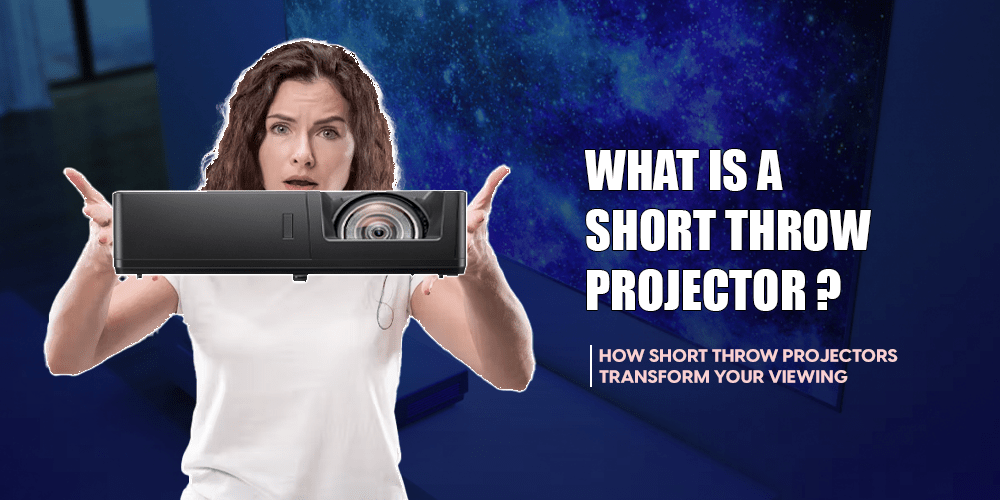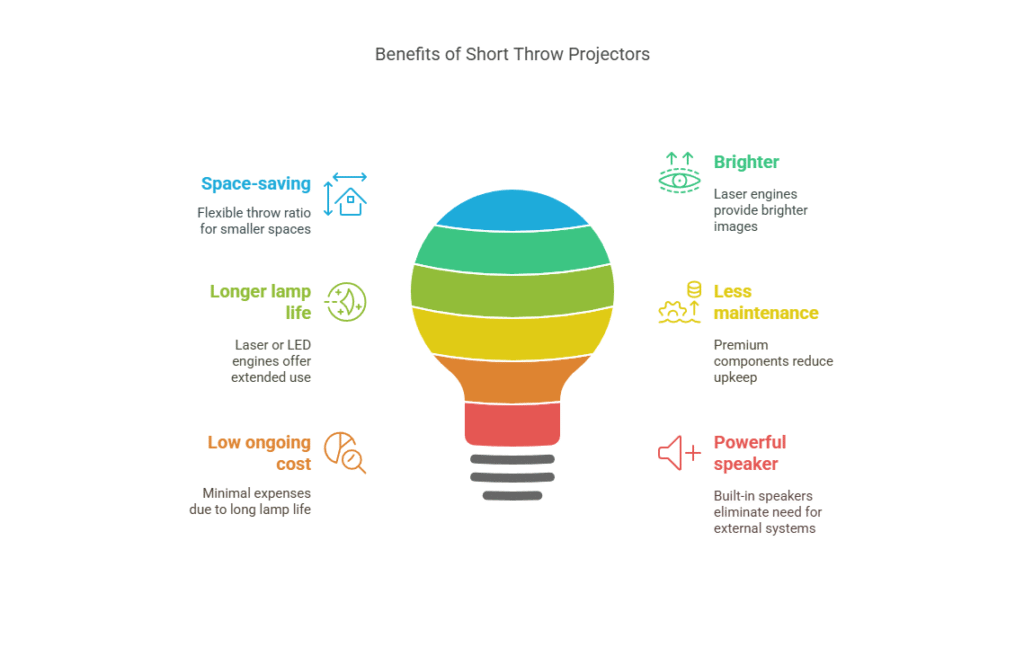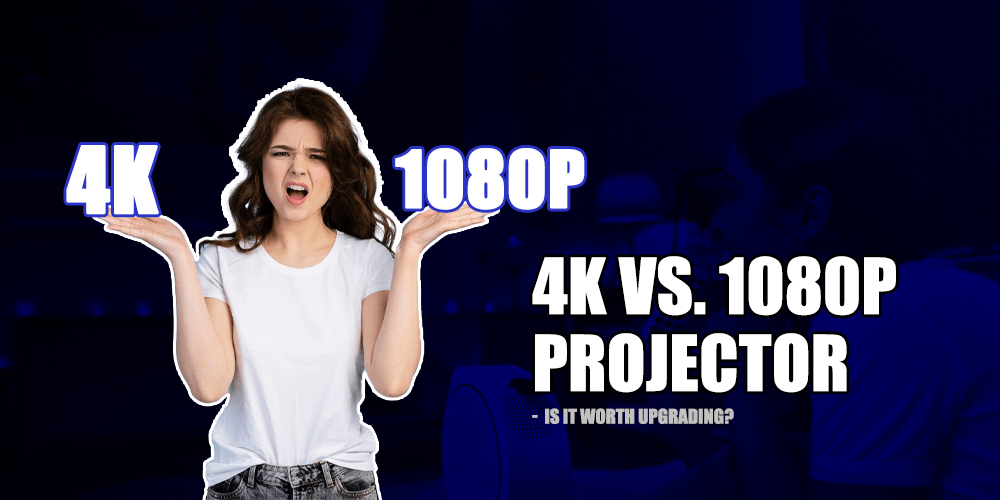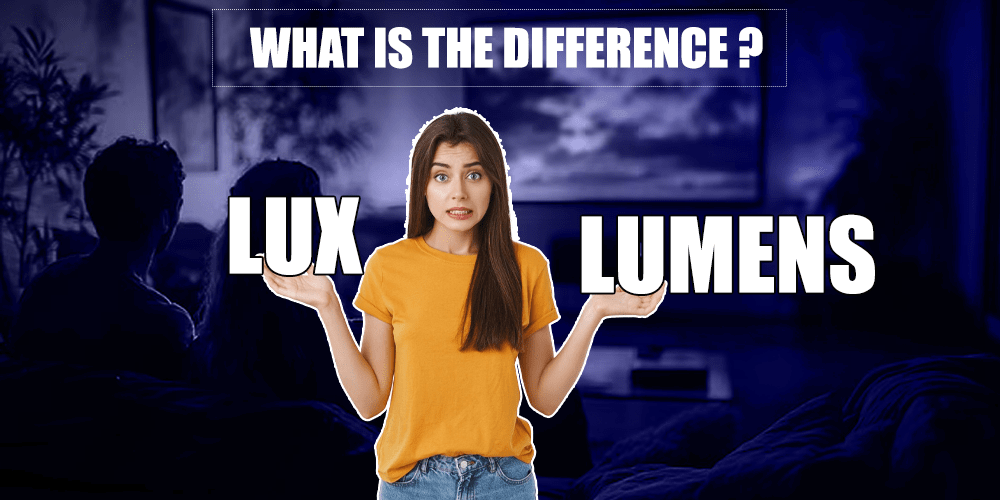Are you struggling to find proper information about what is a short throw projector? We’re here to clear up your confusion and help you understand it better.

Without being too technical,
let’s dive in.
What is a Short-throw projector? Are they for Small Rooms?
A projector that can project a 100+ inches screen from 3 to 8 feet away from the screen is known as a short-throw projector.
Short-throw projectors are a lifesaver for small room owners; we can close our short-throw projector to the screen. Also, the manufacturer rushes to produce a mind-blowing built-in sound system as well to save more space and cost.
What is Throw Distance? Why It matters?
The distance from the projector lens to the image on the screen is known as the throw distance of a projector; Throw distance varies from projector to projector.
What is the throw ratio?
The ratio of throw distance to the Width of the image is known as the throw ratio; we just need to divide the throw distance by the Width of an image to get the throw ratio.
Let’s explore the diagram to understand well:
Here is the Mathematical form:
Throw ratio = distance from projector screen/Width of the image.
Advantages: What Are the Benefits of Short Throw Projectors?

Space-saving:
short-throw projectors are impressive for saving your living room or home theater space, as they are flexible about throw ratio.
Brighter:
Most of the short-throw projectors come with laser engines with ANSI lumens that can project much brighter pictures than normal lamp projectors. A short-throw projector will perform way better than a long-throw projector in a modest ambient.
Related: Read More about Laser Technology In detail
Longer lamp life:
As short-throw projectors have laser or LED engines, you will get almost double the lamp life compared to lamp projectors.
Less maintenance:
Since short-throw projectors don’t have lamps, they mostly use premium stuff like laser engines; you don’t need to do maintenance on a regular basis to keep your projector away from overheating. Let’s explore our Guide about throw ratio for better understanding.
Low ongoing Cost:
Short throw projectors need almost zero ongoing cost because their lamp life is mind-blowing; also, they don’t require any filter or fan replacement rapidly because they are free from overheating.
Powerful speaker:
Most of the short-throw projectors come with powerful built-in speakers or soundbars, so you may not require a separate sound system if you are not a hardcore sound lover.
Disadvantages: What Are the Drawbacks of Short Throw Projectors?
Expensive:
Short-throw projectors are expensive compared to long-throw projectors.
Smaller Screen:
Long throw projectors projects almost doubled image size as compared to short throw.
Some common Throw distances
- Long-throw: A long-throw†projector can project a 100 inches screen from 11-15 feet away; you just need a big room to operate these kinds of projectors
- Short throw: A Short throw projector can project a 100-inch screen from 3 to 8 feet away; you donít need a huge room.
- Ultra short throw (UST): An UST projector can project a 100-inch screen from 1 to 3 inches away; you can operate these kinds of projectors even in a congested cave.
The Major Difference Between Short Throw & Long Throw Projectors
Short-throw projectors can project 100-inch screens from a very close distance of 4 to 8 inches. However, large-throw projectors cannot be projected from a very close distance. Generally, we can get a 100-inch screen from 10 to 15 inches away from the screen.
Of course, there will be differences in brightness, lamp life, and other parameters. If you are interested in getting a detailed comparison, make sure to check out our Guide on normal throw vs. long throw.
FAQs: Frequently Asked Questions
Is a short-throw projector better?
It depends; short-throw projectors are great for medium or small rooms; however, if you have a larger room, you can cut off your cost by getting a large throw projector with tremendous color quality, brightness, and lamp life.
When would you use a short-throw projector?
If you have a small/medium room or want to explore more brightness with less maintenance and ongoing cost, you should go for a short-throw projector.
Why are short-throw projectors so expensive?
They have premium light engines and other kinds of stuff; you will not get ordinary lamps; in most cases, you will get laser engines that can last for more than 20,000 hours.
How long does a short-throw projector last?
The life of a short-throw projector is more than your expectations; I can’t state a certain life of a short-throw projector. However, I have been using my short-throw projector for the last 4 years, even though I didn’t change its laser engine.
As per our experiments, you just need to change the laser engine right after 20,000 to 30,000 hours.
Are short-throw projectors brighter?
Yes, due to the latest light engines, such as lasers, LEDs, etc., short throws are brighter than long throws.
Do short-throw projectors need a special screen?
No, you can use it on ordinary screens; even you can use it on simple paint
Do short-throw projectors need to warm up?
In most cases, they don’t need an initial warm-up because of laser engines.
Can short-throw projectors be ceiling-mounted?
Yes, you will get short-throw projectors that can be mounted on the ceiling as well. BenQ HT671ST and BenQ HT2150ST are examples of ceiling-mounting short-throw projectors.


